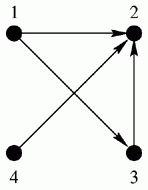
Zadanie Turniej (tur)
Pomóż nam usprawnić bazę zadań!
The Tournament
Memory limit: 32 MB
The International X-Game Federation organises a tournament in which programmes that play this game participate.  programmes numbered from
programmes numbered from  to
to  take part in the competition. The rules of the tournament are as follows: while there remains more than one programme in the tournament, two of them (distinct) are randomly chosen to play a game. The defeated one (there are no draws in the X-Game) drops out of the tournament and the whole procedure is repeated. The sole programme which stays in the tournament after all
take part in the competition. The rules of the tournament are as follows: while there remains more than one programme in the tournament, two of them (distinct) are randomly chosen to play a game. The defeated one (there are no draws in the X-Game) drops out of the tournament and the whole procedure is repeated. The sole programme which stays in the tournament after all  games have been played is the winner.
games have been played is the winner.
The federation has a table of results of previous tournaments. It is known, that the programmes play deterministically (i.e. in repeatable fashion) and in exactly the same way as in previous tournaments. So, if two programmes have already played one against another then their next game will end with the same result. If, however, they have never played against each other, the outcome of the game cannot be predicted - both have a chance of winning. The federation would like to know a list of all programmes which have a chance of winning the tournament.
Task
Write a programme which:
- reads from the standard input the number of participating programmes and the table of results of their previous games,
- determines all programmes which have a chance of winning the tournament,
- writes the outcome to the standard output.
Input
The first line of the input contains an integer  ,
,  . The next
. The next  lines contain the table of results of previous games:
lines contain the table of results of previous games:  'st line contains an integer
'st line contains an integer  ,
,  , followed by
, followed by  numbers of programmes, not equal to
numbers of programmes, not equal to  , in increasing order - those are the numbers of programmes, with which the programme
, in increasing order - those are the numbers of programmes, with which the programme  has previously won. The numbers in lines are separated by single spaces. The number of all known results of previous games does not exceed
has previously won. The numbers in lines are separated by single spaces. The number of all known results of previous games does not exceed  .
.
Output
The first and only line of the standard output should contain the number  of programmes which have a chance of winning the tournament, followed by
of programmes which have a chance of winning the tournament, followed by  numbers identifying those programmes, in increasing order. The numbers should be separated by single spaces.
numbers identifying those programmes, in increasing order. The numbers should be separated by single spaces.
Example
For the input data:
4 2 2 3 0 1 2 1 2

the correct result is:
3 1 3 4
Task author: Bartosz Walczak.
Kontakt
In the event of technical difficulties with Szkopuł, please contact us via email at [email protected].
If you would like to talk about tasks, solutions or technical problems, please visit our Discord servers. They are moderated by the community, but members of the support team are also active there.

 English
English